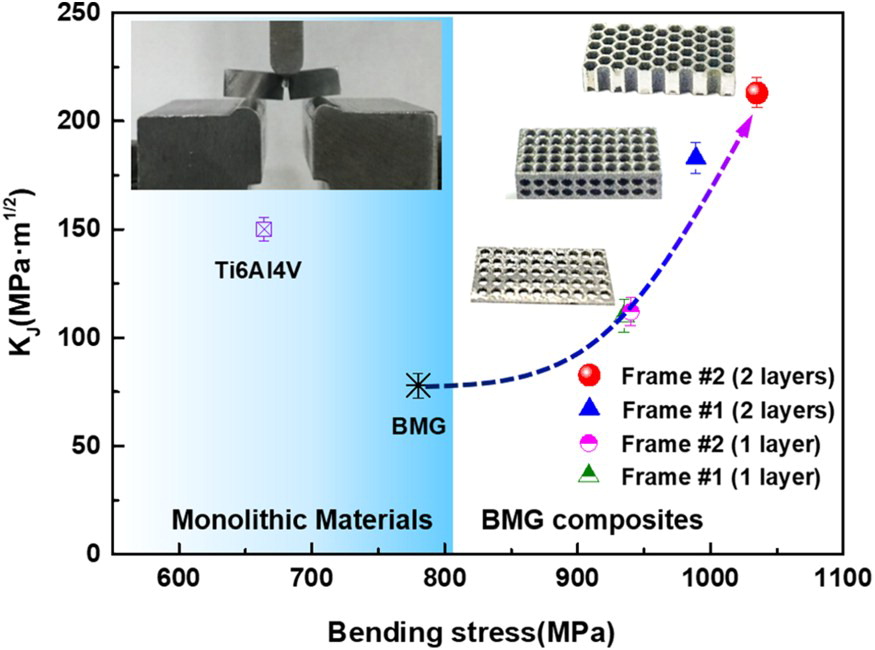Researchers from China have developed a promising route for the fabrication of strong-and-tough metallic BMG composites, using a combination of ultrasonic vibration-assisted thermoplastic forming and 3D printing.
Bulk metallic glasses (BMGs) are a unique class of materials that possess an amorphous atomic-level structure and a variety of desirable mechanical, chemical, and physical properties. However, the application of the material has been hindered by its intrinsic brittleness and processing limitations at ambient temperature.
To overcome this limitation, the researchers 3D printed titanium alloy frames, which were then thermoplastic formed with a bulk metallic glass matrix under ultrasonic vibration, forming sandwich-structured bulk metallic glass composites. Reinforced by the titanium alloy frame, the BMG composites exhibited a fracture toughness higher than that of monolithic BMG.

What are Bulk Metallic Glasses?
BMGs are non-crystalline metallic alloys with a unique, disordered atomic structure and glass-to-supercooled liquid transition. Fundamentally different from traditional amorphous metal alloys, BMGs are formed at very low critical cooling rates, as opposed to the rapid cooling rates of amorphous metals. They exhibit useful engineering properties of high mechanical strength at low temperature, high flexibility at high temperature, and a number of superior chemical and physical properties, including high corrosion resistance.
The material’s malleability combined with its high strength makes BMGs a promising option for exploration via additive manufacturing, as discussed by Tobias Caspari, head of 3D Printing at Heraeus New Businesses, one of the first companies to succeed in 3D printing amorphous metals: “Amorphous metals will change our future. They possess a wide variety of previously incompatible characteristics: They are very strong and yet malleable, as well as harder and more corrosion-resistant than conventional metals.”
In 3D printing, BMGs has been the subject of a number of research initiatives and critical applications. In 2019 a team of researchers at the Huazhong University of Science and Technology (HUST), China, discovered a way to scale-up the 3D printing of BMGs in order to suppress the micro-cracks that can occur in the material during the 3D printing process. Furthermore, a team led by technologist Douglas Hofmann at NASA’s Jet Propulsion Laboratory (JPL) in Pasadena, California, used BMG to fabricate a gear that works well in the -328 degrees Fahrenheit (-200°C) temperatures of space.

Combining ultrasonic vibration-assisted thermoplastic forming with 3D printing
In this new study, the authors explain that industrial applications of BMGs have been prevented by the material’s intrinsic brittleness, and its tendency to form cracks at ambient temperatures.
The researchers identified a method to strengthen the composition of BMG composites through the ex-situ addition of crystalline phases. Inspired by the aseismic structure of skyscrapers, which exhibit excellent resistance to fracture, the team opted to design and 3D print Ti6Al4V titanium alloy frames in accordance with the aseismic structure of these buildings. Using SLM additive manufacturing technology, the frames were fabricated with a length of 15 mm, a width of 8 mm and a thickness of 10 mm using commercial Ti6Al4V powders.

The Ti6Al4V frames, featuring a tubular structure, were then thermoplastic formed with a BMG matrix known as Zr35Ti30Be26.75Cu8.25. Specifically, an ultrasonic vibration-assisted thermoplastic forming technique was introduced to extrude the Zr35Ti30Be26.75Cu8.25 BMG into the internal space of Ti6Al4V frame, thus enabling a metallurgical bonding at the interface between two phases through ultrasonic welding.
The researchers found that, by tuning the geometry of the Ti6Al4V frame, the BMG composites exhibited high fracture toughness of about 213 MPa m1/2 and a bending strength of about 1 GPa, a figure 2.3 times higher than that of monolithic BMG. Concluding the study, the researchers state that: “The fabricated Zr-BMG composites exhibited conspicuously enhanced fracture toughness, for the existence of Ti6Al4V frame which proliferates multiple shear bands and deflects the propagation of cracks. Combining ultrasonic vibration-assisted thermoplastic forming with 3D printing provides a promising route for the fabrication of BMG composites.”
The paper, “Metal frame reinforced bulk metallic glass composites”, is published in the journal Material Research Letters. It is written by Zu Li, Ning Li and Lin Liu of the Huazhong University of Science and Technology, and Meng Zhang of Jinan University Guangzhou.
The nominations for the 2020 3D Printing Industry Awards are now open. Who do you think should make the shortlists for this year’s show? Have your say now.
Subscribe to the 3D Printing Industry newsletter for the latest news in additive manufacturing. You can also stay connected by following us on Twitter and liking us on Facebook.
Looking for a career in additive manufacturing? Visit 3D Printing Jobs for a selection of roles in the industry.
Featured image shows the fabricated frame reinforced BMG composites. Image via Materials Research Letters.


